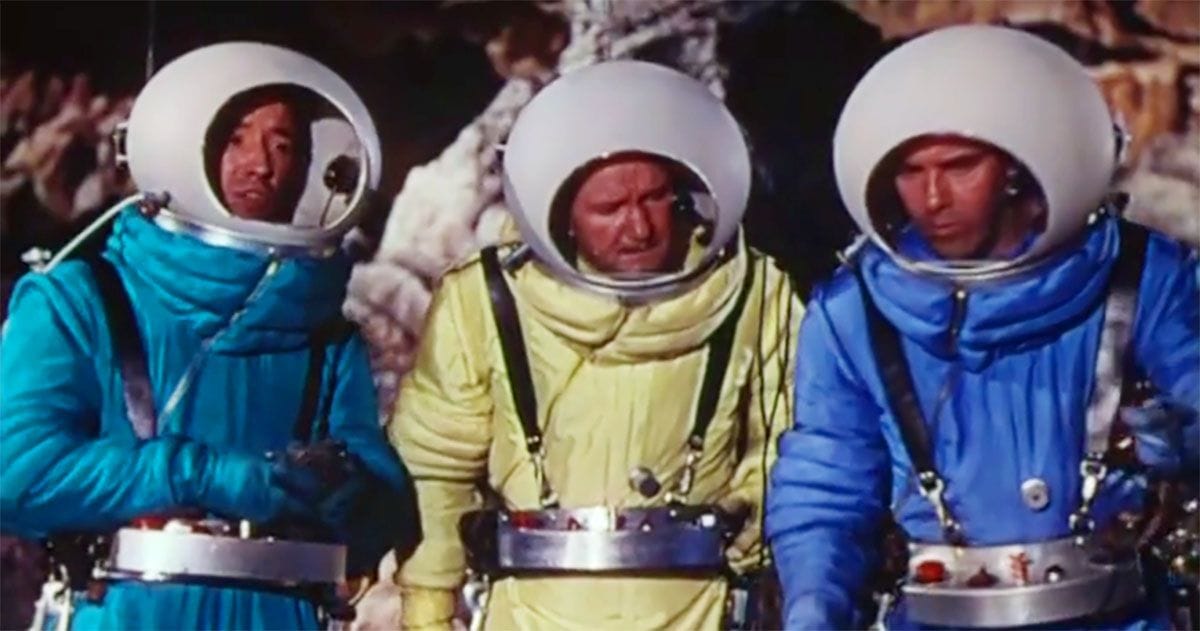"Destination Moon" Captured the Spirit of 1950s Ambition
“Destination Moon” (1950), directed by Irving Pichel, explores the ambition of space travel, blending nostalgia and science with a rating of 6.3/10.

“Destination Moon,” released in 1950 and directed by Irving Pichel, is a landmark in American science fiction cinema.
Produced by the visionary George Pal, the film draws its screenplay from the work of renowned science fiction author Robert A. Heinlein, alongside contributions from Rip Van Ronkel and James O’Hanlon.
The cast, featuring actors John Archer, Warner Anderson, Tom Powers, and Dick Wesson, embarks on an audacious journey as a team of scientists and industrialists who unite to launch the first crewed expedition to the moon.

While “Destination Moon” is historically significant for its serious treatment of space travel and scientific accuracy for the era, it stands as a testament to the complex interplay between aspiration and reality in 1950s America.
Through a lens tinted by Cold War sentiments, the film portrays the moon as a contested territory ripe for capitalist conquest, marked by a palpable distrust of government narratives. The technical achievements and notable artistic contributions, especially the stunning matte paintings by Chesley Bonestell, elevate the film visually, even as its characterization and pacing leave much to be desired.
Ultimately, “Destination Moon” serves both as a historical curiosity and a reflection of its time, inviting viewers to ponder the future of space exploration while grappling with its own narrative shortcomings.
| Title | Destination Moon |
| Director | Irving Pichel |
| Writer | Alford Van Ronkel, Robert A. Heinlein, James O'Hanlon |
| Actors or actresses | John Archer, Warner Anderson, Tom Powers |
| Rated | Approved |
| Runtime | 92 min |
| Box Office | $5,000,000 |
| U.S. Release Date | 01 Aug 1950 |
| Quality Score | 6.3/10 |
Synopsis
The plot of “Destination Moon” revolves around the ambitious endeavor of a private consortium led by industrialist Jim Barnes, played by John Archer.
The consortium aims to break the barriers of terrestrial limitations by orchestrating humanity's first lunar mission. They assemble a competent team consisting of scientists and engineers to devise a spacecraft capable of making this monumental journey.
As the crew prepares for the mission, they must confront various technical challenges and ethical dilemmas that arise from their pursuit of knowledge. Their resolve is tested as they grapple with the realities of space travel, including concerns about safety and the unpredictable nature of the lunar environment. Tension mounts within the group, particularly between Barnes and his scientific peers, as they navigate the precarious balance between ambition and caution.

Upon launch, the audience is treated to a series of scientifically informed scenes that depict the intricacies of spaceflight. The film meticulously details the launch sequence, the journey through the void, and the eventual landing on the moon's stark surface. Once there, the crew experiences the disorienting effects of reduced gravity and unprecedented vistas that provoke wonder and introspection.
Throughout their time on the moon, the crew collects samples and conducts experiments, showcasing the promise of scientific discovery. However, their mission is not without peril. A mechanical failure threatens their return journey, emphasizing the inherent dangers of space exploration. The film culminates in a suspenseful sequence as the crew must harness their collective ingenuity and teamwork to ensure their survival and safe return to Earth.
In its climax, “Destination Moon” not only serves as an adventure narrative but also raises profound questions regarding humanity's role in the cosmos and the responsibilities that accompany such endeavors. Ultimately, the film becomes a tribute to human ingenuity and the spirit of exploration, inviting viewers to reflect on the future of space as a new frontier.
Themes
“Destination Moon” evokes a captivating experience that transcends its time, bringing forth major themes of ambition, human ingenuity, and the ethical implications of exploration. From the moment the audience is transported into its narrative, they are enveloped in a sense of wonder mingled with trepidation, precisely reflecting the complex emotions that accompany humanity's quest for knowledge beyond the familiar confines of Earth.
A recurring theme in the film is the ambitious drive to push boundaries. This ambition is embodied in the character of Jim Barnes, whose visionary zeal is counterbalanced by the pragmatic concerns of his scientific colleagues. The film beautifully illustrates the dichotomy between ambition and caution, portraying how the desire to achieve remarkable feats can often clash with the sobering realities of their implications. This internal conflict resonates with viewers, echoing the struggle faced in modern scientific pursuits, where the thirst for discovery often comes at a cost.
The film’s visual storytelling elevates its central themes. The matte paintings by Chesley Bonestell, breathtaking in both scale and detail, provide a poignant representation of the moon’s desolate beauty. These images contrast sharply with the bustling life of Earth, further emphasizing the allure and danger that space holds. The cinematography showcases not only the technical aspects of rocketry but also human emotions; the crew’s excitement and anxiety are palpable and infectious, making viewers feel as if they are part of the journey.

Moreover, the sound design and musical score complement the film's themes effectively. The score, with its sweeping orchestral arrangements, captures the grandiosity of space exploration while simultaneously underscoring the moments of tension and vulnerability the crew faces during their journey. One can almost hear the soft hum of life support systems on the spacecraft and the ethereal silence of the lunar surface, creating an immersive auditory landscape that contributes to the film’s emotional weight.
Another significant theme within “Destination Moon” is the exploration of humanity's relationship with technology. As the scientists and engineers develop the launch vehicle, the film raises questions about the ethics of technological advancement. Are innovations that propel us forward worth the risks they entail? This inquiry serves as a reflection of the post-World War II era, where technological progress was both celebrated and scrutinized. The film grapples with this duality, making it both a celebration and a cautionary tale.
Furthermore, the film’s portrayal of the moon as a contested territory stimulates discourse about exploration as an extension of human ambition. The desire to claim and conquer new frontiers is indicative of a broader narrative rooted in capitalism and competition. Yet, the film subtly critiques this viewpoint as it reveals the human cost of such endeavors. This struggle for dominance is played out within the confines of the crew dynamics, as personal agendas clash against the collective goal of survival.
“Destination Moon” provides audiences with a thoughtful meditation on the nature of exploration, human ambition, and the intricate relationship between progress and caution. As the crew returns home with invaluable knowledge, the film leaves viewers to ponder not just the triumphs of a successful mission, but also the moral responsibilities that accompany such powerful scientific advancements.
The personal impressions carved by its themes linger long after the credits roll, making “Destination Moon” not merely a film, but an enduring exploration of what it means to reach for the stars.
Who Will Enjoy Destination Moon
“Destination Moon” appeals to those who appreciate the historical context of cinema and the evolution of science fiction.
Audiences accustomed to the polished visuals and narratives of contemporary films may find an intriguing contrast in the film's straightforward storytelling and its earnest exploration of scientific themes. This makes the film rewarding for those who seek to understand the roots of modern space exploration narratives.
The film particularly merits viewing during gatherings or discussions centered on science fiction's impact on cinema and culture. It serves as an ideal entry point for educators seeking to engage students in conversations about the early perceptions of space travel and the technological aspirations of the post-war era.
For those interested in film history, “Destination Moon” marks an essential milestone in the genre, providing insight into how societal aspirations shaped cinematic storytelling prior to the actual achievements of the space race.
Additionally, individuals captivated by the interplay between ambition and ethical considerations surrounding technological advancements will find much to ponder in this film. The interactions among the crew serve to spark discussions regarding the dilemmas faced by scientists and engineers today. Enthusiasts of meticulous craftsmanship in filmmaking may appreciate the artistry behind Bonestell's matte paintings and the film's effort to incorporate scientific principles into its narrative.

As one reflects on “Destination Moon,” it is clear that the film resonates with themes of human aspiration, the complexities of exploration, and the delicate balance between ambition and caution. While its pacing may seem slow compared to modern films, it fosters a contemplative experience that contrasts with today's frenetic storytelling. The film's visual and auditory qualities, despite certain limitations in character development and dialogue, contribute to its lasting allure.
In summation, “Destination Moon” remains a thought-provoking piece that offers a glimpse into the hopes and fears of an earlier age, mirroring the ever-evolving relationship between humanity and space exploration. Its historical significance and thematic depth render it a noteworthy watch for those interested in the nexus of filmmaking, science, and the human condition, inviting viewers to contextualize the present through the lens of the past. Whether watched alone or in a group setting, the film stands as an embodiment of the spirit of inquiry that continues to drive exploration today.

